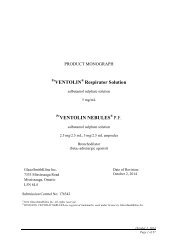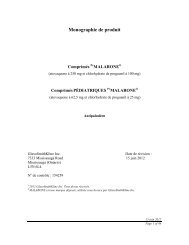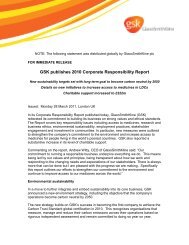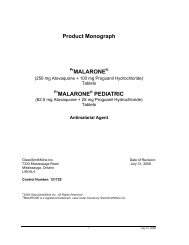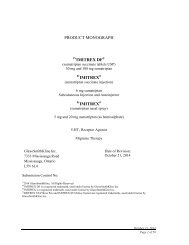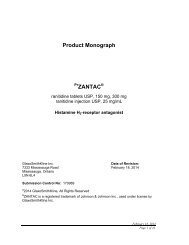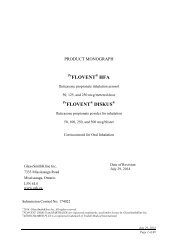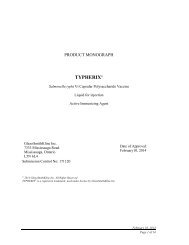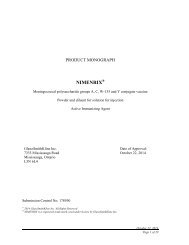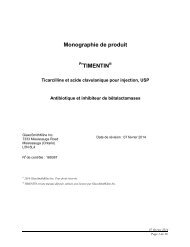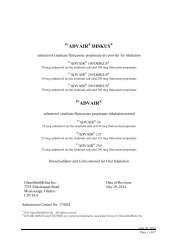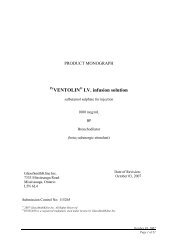Prescribing Information PARNATE - GlaxoSmithKline
Prescribing Information PARNATE - GlaxoSmithKline
Prescribing Information PARNATE - GlaxoSmithKline
Create successful ePaper yourself
Turn your PDF publications into a flip-book with our unique Google optimized e-Paper software.
<strong>Prescribing</strong> <strong>Information</strong><br />
Pr <strong>PARNATE</strong> ®<br />
tranylcypromine tablets USP<br />
ANTIDEPRESSANT<br />
<strong>GlaxoSmithKline</strong> Inc.<br />
7333 Mississauga Road<br />
Mississauga, Ontario<br />
L5N 6L4<br />
Date of Revision:<br />
June 19, 2013<br />
Submission Control No.<br />
© 2013 <strong>GlaxoSmithKline</strong> Inc. All Rights Reserved<br />
® <strong>PARNATE</strong> is a registered trademark, used under license by <strong>GlaxoSmithKline</strong> Inc.<br />
_________________________________________________________________________________________________<br />
1 June 19, 2013
<strong>Prescribing</strong> <strong>Information</strong><br />
Pr <strong>PARNATE</strong> ®<br />
tranylcypromine tablets USP<br />
10 mg<br />
Antidepressant<br />
Clinical Pharmacology<br />
Tranylcypromine is a non-hydrazine monoamine oxidase (MAO) inhibitor with a rapid<br />
onset of activity. It increases the concentration of epinephrine, norepinephrine, and<br />
serotonin in storage sites in the nervous system. In theory, the increased concentration<br />
of monoamines in the brainstem is the basis for its antidepressant activity.<br />
Tranylcypromine differs from other MAO inhibitors in being a reversible inhibitor. When<br />
tranylcypromine is withdrawn, monoamine oxidase activity is generally restored within a<br />
week, although the drug is excreted in 24 hours.<br />
Indications and Clinical Use<br />
<strong>PARNATE</strong> ® has been used successfully to treat psychotic depressive states such as:<br />
depressive phase of manic-depressive psychosis, involutional melancholia, reactive<br />
depression and psychoneurotic depression of moderate to severe intensity.<br />
In the psychiatric treatment of severe endogenous depression, it is impossible to predict,<br />
with presently known data, which patients will respond best to <strong>PARNATE</strong> ® and which to<br />
electroconvulsive therapy (ECT). The drug may be indicated in some reactive<br />
depressions in which ECT is not indicated.<br />
2 June 19, 2013
<strong>PARNATE</strong> ® is not recommended for use in mild depressive states resulting from<br />
temporary situational difficulties.<br />
Note: Because <strong>PARNATE</strong> ® is a potent agent with the capability of producing serious<br />
side effects (e.g., hypertensive crises, sometimes complicated by fatal intracranial<br />
bleeding); its use should be reserved for patients who can be closely supervised.<br />
Before prescribing <strong>PARNATE</strong> ® , the physician should be thoroughly familiar with<br />
information on its dosage, side effects, and contraindications, as well as the principles of<br />
MAO inhibitor therapy and the side effects of this class of drugs as reported in the<br />
literature. The physician should also be familiar with the symptomatology of mental<br />
depression and alternate methods of treatment to aid in the careful selection of patients<br />
for <strong>PARNATE</strong> ® therapy.<br />
Selecting the Patient:<br />
1. <strong>PARNATE</strong> ® should be used for the symptomatic treatment of moderate to severe<br />
depression. It is not recommended for those mild depressive reactions where<br />
more conservative therapy is indicated.<br />
2. <strong>PARNATE</strong> ® should be reserved for those patients who can be followed closely.<br />
Blood pressure should be recorded periodically to detect evidence of pressor<br />
response to <strong>PARNATE</strong> ® therapy.<br />
3. <strong>PARNATE</strong> ® should not be used in patients with cerebrovascular or<br />
cardiovascular disorders (e.g., arteriosclerosis, hypertension). (See<br />
CONTRAINDICATIONS.)<br />
4. <strong>PARNATE</strong> ® should not be used in patients receiving any other antidepressant<br />
medication. (See CONTRAINDICATIONS.)<br />
5. <strong>PARNATE</strong> ® is not recommended for patients with a history of recurring or<br />
frequent headaches, especially the tension and vascular types.<br />
6. <strong>PARNATE</strong> ® should not be used alone in patients with marked<br />
psychomotoragitation, since it is recognized that antidepressant drugs can<br />
aggravate some co-existing symptoms such as agitation or anxiety.<br />
3 June 19, 2013
<strong>PARNATE</strong> ® combined with trifluoperazine: <strong>PARNATE</strong> ® has been combined with<br />
trifluoperazine, in the treatment of co-existing anxiety and depression. Such combined<br />
therapy has been found particularly valuable when used to treat depressed patients in<br />
whom a persistent disorder of mood is associated with anxiety, moderate agitation,<br />
inappropriate mental symptoms (such as unnatural fears or suspicions and phobias) or<br />
improper response to single-agent therapy.<br />
Combined <strong>PARNATE</strong> ® - trifluoperazine therapy has been used successfully in the<br />
treatment of psychiatric conditions such as psychoneurotic depression, agitated<br />
depression, schizo-affective disorders and pseudoneurotic schizophrenia. If the patient<br />
appears to have a pure depression, <strong>PARNATE</strong> ® should be used alone and, similarly, if<br />
the symptoms appear to indicate a pure anxiety state, trifluoperazine should be used<br />
first. The combined therapy has frequently displayed striking effectiveness in patients<br />
who obtained little benefit from treatment with a succession of single drugs.<br />
For comprehensive prescribing information on trifluoperazine, refer to <strong>Prescribing</strong><br />
<strong>Information</strong> on that product.<br />
<strong>PARNATE</strong> ® is Contraindicated:<br />
Contraindications<br />
In patients with a previous history of hypersensitivity to tranylcypromine or excipients.<br />
In patients with cerebrovascular or cardiovascular disorders or a history of recurrent or<br />
frequent headaches. <strong>PARNATE</strong> ® should not be administered to patients with confirmed<br />
or suspected cerebrovascular defect, hypertension or cardiovascular disease. The drug<br />
should be used with caution in individuals beyond the age of 60 because of the<br />
possibility of existing cerebral sclerosis with damaged vessels.<br />
In patients with liver damage or blood dyscrasias. Extensive clinical use and laboratory<br />
tests have revealed no evidence of liver toxicity or blood dyscrasias due to <strong>PARNATE</strong> ®<br />
therapy. Because rare cases of hepatitis have been reported, it is recommended that<br />
patients with known liver damage or blood dyscrasias should not be treated with<br />
<strong>PARNATE</strong> ® .<br />
4 June 19, 2013
In pheochromocytoma. <strong>PARNATE</strong> ® should not be used in the presence of known or<br />
suspected pheochromocytoma, as such tumours secrete pressor substances.<br />
In combination with certain drugs. Because the effect of many antidepressant drugs<br />
may persist for 10 to 20 days, do not commence <strong>PARNATE</strong> ® therapy within less than a<br />
week of discontinuing treatment with such drugs; then use half the normal dosage for the<br />
first week. Similarly, allow one week to elapse between the discontinuance of<br />
<strong>PARNATE</strong> ® and the administration of any other drug that is contraindicated with<br />
<strong>PARNATE</strong> ® such as:<br />
1. Other monoamine oxidase inhibitors (MAOIs) such as isocarboxazid and<br />
phenelzine sulfate.<br />
2. Dibenzazepine derivatives such as amitriptyline, nortriptyline, protriptyline,<br />
desipramine, imipramine, doxepin, perphenazine, carbamazepine,<br />
cyclobenzaprine, amoxapine, maprotiline and trimipramine, as combination with<br />
these drugs may induce hypertensive crises or severe convulsive seizures.<br />
3. Sympathomimetics including amphetamines, ephedrine, methyldopa, dopamine,<br />
and levodopa; as well as tryptophan. These may result in potentiation,<br />
precipitating hypertension, severe headache, and hyperpyrexia. Cerebral<br />
(subarachnoid) hemorrhage may also occur. These compounds may be found in<br />
many herbal preparations, as well as over-the-counter drugs, such as cold, hay<br />
fever, energy-enhancing and weight-reducing preparations. The combination of<br />
MAOIs and tryptophan has been reported to cause behaviour and neurologic<br />
syndromes including disorientation, confusion, amnesia, delirium, agitation,<br />
hypomanic signs, ataxia, myoclonus, hyperreflexia, shivering, ocular oscillations<br />
and Babinski signs.<br />
4. SSRIs or SNRIs (eg. venlafaxine): There have been reports of serious,<br />
sometimes fatal reactions when MAOIs are given before, with, or shortly after<br />
discontinuation with some SSRIs or SNRIs. It is recommended that MAOIs are<br />
not used in combination with SSRIs or SNRIs. If SSRIs or SNRIs are used<br />
consecutively, a suitable washout period should be observed. The following is a<br />
guide, but prescribing information for individual products should be consulted:<br />
5 June 19, 2013
- MAOI followed by SSRI or SNRI (eg. venlafaxine) - 2 weeks<br />
- Fluoxetine followed by MAOI - 5 weeks<br />
- Other SSRI followed by MAOI - 2 weeks<br />
- SNRI (eg. venlafaxine) followed by MAOI – 1 week<br />
5. Other drugs: dextromethorphan, buspirone HCl.<br />
In combination with foods with a high tyramine content.<br />
Tyramine is normally metabolized by monoamine oxidase in the intestinal and hepatic<br />
cells. When monoamine oxidase is inhibited, tyramine absorbed from the gastrointestinal<br />
tract passes freely into the circulation. It releases norepinephrine from adrenergic<br />
neurones causing exaggerated hypertensive and other effects.<br />
When excessive amounts of tyramine are consumed in conjunction with <strong>PARNATE</strong> ® , or<br />
within 2 weeks of stopping treatment, a serious and sometimes fatal hypertensive<br />
reaction may occur.<br />
Tyramine occurs naturally in some foods or may occur from the bacterial breakdown of<br />
protein in foods which are fermented, aged or spoiled.<br />
Foods that have reliably been shown to contain a high tyramine content and may also<br />
have been reported to induce a serious hypertensive reaction when consumed with<br />
<strong>PARNATE</strong> ® are contraindicated.<br />
Foods that are contraindicated in combination with <strong>PARNATE</strong> ® :<br />
All matured or aged cheeses (exceptions: fresh cottage cheese, cream cheese,<br />
ricotta and processed cheese). All non-cheese dairy products can be consumed<br />
providing they are fresh.<br />
<br />
<br />
All aged, cured or fermented meat, fish or poultry (note: meat, fish or poultry that has<br />
not undergone aging, curing or fermenting and that is bought fresh, stored correctly<br />
and eaten fresh is not contraindicated).<br />
All fermented soybean products (e.g. soy sauce, miso, fermented tofu).<br />
6 June 19, 2013
Sauerkraut.<br />
Fava or broad bean pods.<br />
Banana peel (but not the pulp).<br />
Concentrated yeast extracts (e.g. Marmite spread).<br />
All tap/draught beers (Note: some bottled beers, including non-alcoholic beer, may<br />
also pose a risk).<br />
Patients should be advised to minimize or avoid use of all alcoholic beverages while<br />
taking <strong>PARNATE</strong> ® .<br />
Patients should be advised to adhere to the following dietary guidance about eating<br />
fresh foods:<br />
Foods may be deliberately aged as part of their processing and these are<br />
contraindicated (see list above). Foods may also naturally age over time, even if they<br />
are refrigerated. It is therefore extremely important that patients are instructed to buy<br />
and eat only fresh foods or those which have been properly frozen. They should avoid<br />
eating foods if they are unsure of their storage conditions or freshness and they should<br />
be cautious of foods of unknown age or composition even if refrigerated.<br />
The longer food is left to deteriorate and the larger the quantity of food eaten, the greater<br />
the potential quantity of tyramine ingested. Where there is any doubt, patients should be<br />
advised to either avoid the food or consume in strict moderation if it is not otherwise<br />
contraindicated.<br />
Patients should also be warned that tyramine levels may vary by brand or even batch<br />
and a person may absorb different amounts of tyramine from a particular food at<br />
different times. Therefore, if they have accidentally consumed a prohibited food on one<br />
occasion and not had a reaction, this does not mean that they will not have a serious<br />
hypertensive reaction if they consume the same food on a different occasion.<br />
7 June 19, 2013
Warnings<br />
Hypertensive crisis: The most important adverse reaction associated with <strong>PARNATE</strong> ® is<br />
hypertensive crisis, which has sometimes been fatal. This response is not usually doserelated.<br />
It is associated with a distinctive reaction characterized by some or all of the<br />
following symptoms: occipital headache which may radiate frontally, palpitation, neck<br />
stiffness or soreness, nausea or vomiting, sweating (sometimes with fever and<br />
sometimes with cold, clammy skin) with early pallor followed later by flushing, and<br />
photophobia. Either tachycardia or bradycardia may be present, sometimes associated<br />
with constricting chest pain. Mydriasis may occur.<br />
The occipital headache, together with pain and stiffness in the cervical muscles, may<br />
mimic subarachnoid hemorrhage, but can equally be associated with actual intracranial<br />
bleeding, as in other conditions where a sudden rise in blood pressure occurs. Cases of<br />
such bleeding have been reported, some of which have been fatal.<br />
Blood pressure should be followed closely in patients taking <strong>PARNATE</strong> ® to detect<br />
evidence of any pressor response. It is emphasized that full reliance should not be<br />
placed on blood pressure readings, but that the patient should also be observed<br />
frequently.<br />
Therapy should be discontinued immediately upon the occurrence of palpitation or<br />
frequent headache during <strong>PARNATE</strong> ® therapy. These signs may be prodromal of a<br />
hypertensive reaction. Patients should be instructed to report promptly the occurrence<br />
of headache or other symptoms.<br />
If a hypertensive reaction occurs, <strong>PARNATE</strong> ® should be discontinued and therapy to<br />
lower blood pressure should be given immediate consideration. Headache tends to<br />
abate as blood pressure decreases. On the basis of present evidence, phentolamine is<br />
recommended for use in acute cases. (the dosage reported for phentolamine is 5 mg<br />
I.V. administered slowly.) Do not use parenteral reserpine or rauwolfia alkaloids for the<br />
treatment of a hypertensive crisis as they may, by releasing catecholamines, exacerbate<br />
the condition. Care should be taken to administer these drugs in such a way as to avoid<br />
producing an excessive hypotensive effect. Fever should be managed by means of<br />
8 June 19, 2013
external cooling. Other symptomatic and supportive measures may be desirable in<br />
particular cases. Acute distress generally subsides in 24 hours or less. For milder<br />
reactions, the more moderate adrenolytic action of injectable chlorpromazine may be<br />
more appropriate.<br />
Hypotension, which may be postural, has been observed during <strong>PARNATE</strong> ® therapy,<br />
particularly at doses above 30 mg daily. It is seen most commonly (but not exclusively)<br />
in patients with pre-existing hypertension. In most instances, it affects the systolic<br />
readings. Rare instances of syncope have been seen. Dosage increases should be<br />
made more gradually in patients showing a tendency toward hypotension at the starting<br />
dose. Postural hypotension can usually be relieved by having the patient lie down until<br />
blood pressure returns to normal. This side effect is usually temporary, but if it persists,<br />
<strong>PARNATE</strong> ® should be discontinued. Blood pressure usually returns rapidly to pretreatment<br />
levels upon discontinuation of <strong>PARNATE</strong> ® .<br />
Also, when <strong>PARNATE</strong> ® is combined with those phenothiazine derivatives or other<br />
compounds known to cause hypotension, the possibility of additive hypotensive effects<br />
should be considered.<br />
Potential Association with the Occurrence of Behavioral and Emotional Changes,<br />
Including Self-Harm:<br />
It is unknown whether increased risk of suicidal ideation and behavior is associated with<br />
the use of <strong>PARNATE</strong> ® in pediatric patients and/ or adults.<br />
However, recent analyses of placebo-controlled clinical trial safety databases from<br />
SSRIs and other newer antidepressants suggest that use of these drugs in patients<br />
under the age of 18 may be associated with behavioral and emotional changes,<br />
including an increased risk of suicidal ideation and behavior over that of placebo. Thus,<br />
rigorous clinical monitoring for suicidal ideation or other indicators of potential for suicidal<br />
behavior is advised in patients of all ages given any antidepressant drug. This includes<br />
monitoring for emotional and behavioral changes.<br />
Clinical worsening and suicide risk in adults with psychiatric disorders: Patients with<br />
depression may experience worsening of their depressive symptoms and/or the<br />
emergence of suicidal ideation and behaviours (suicidality) whether or not they are<br />
9 June 19, 2013
taking antidepressant medications. This risk persists until significant remission occurs.<br />
As improvement may not occur during the first few weeks or more of treatment, patients<br />
should be closely monitored for clinical worsening (including development of new<br />
symptoms) and suicidality, especially at the beginning of a course of treatment, or at the<br />
time of dose changes, either increases or decreases. It is general clinical experience<br />
with all antidepressant therapies that the risk of suicide may increase in the early stages<br />
of recovery.<br />
Patients with a history of suicidal behaviour or thoughts, and those patients exhibiting a<br />
significant degree of suicidal ideation prior to commencement of treatment, are at a<br />
greater risk of suicidal thoughts or suicide attempts, and should receive careful<br />
monitoring during treatment.<br />
Patients (and caregivers of patients) should be alerted about the need to monitor for any<br />
worsening of their condition (including development of new symptoms) and/or the<br />
emergence of suicidal ideation/behaviour or thoughts of harming themselves and to seek<br />
medical advice immediately if these symptoms present. It should be recognised that the<br />
onset of some neuropsychiatric symptoms could be related either to the underlying<br />
disease state or the drug therapy (see Mania and bipolar disorder below).<br />
Consideration should be given to changing the therapeutic regimen, including possibly<br />
discontinuing the medication, in patients who experience clinical worsening (including<br />
development of new symptoms) and/or the emergence of suicidal ideation/behaviour,<br />
especially if these symptoms are severe, abrupt in onset, or were not part of the patient's<br />
presenting symptoms.<br />
Mania and bipolar disorder: A major depressive episode may be the initial presentation<br />
of bipolar disorder. It is generally believed (though not established in controlled trials)<br />
that treating such an episode with an antidepressant alone can increase the likelihood of<br />
precipitation of a mixed/manic episode in patients at risk for bipolar disorder. Prior to<br />
initiating treatment with an antidepressant, patients should be adequately screened to<br />
determine if they are at risk for bipolar disorder; such screening should include a detailed<br />
psychiatric history, including a family history of suicide, bipolar disorder, and depression.<br />
10 June 19, 2013
As with all antidepressants, tranylcypromine should be used with caution in patients with<br />
a history of mania.<br />
Precautions<br />
Interactions with Other Drugs (see also CONTRAINDICATIONS): In general, the<br />
physician should bear in mind the possibility of a lowered margin of safety when<br />
<strong>PARNATE</strong> ® is administered in combination with potent drugs and should adjust dosage<br />
carefully.<br />
A marked potentiating effect has been reported on some central nervous system<br />
depressants such as morphine, meperidine, barbiturates and alcohol. For this reason,<br />
narcotics and barbiturates should be used conservatively with <strong>PARNATE</strong> ® , and patients<br />
should be warned that the drug may poteniate the effects of alcoholic beverages.<br />
Caution should be exercised when giving <strong>PARNATE</strong> ® with hypotensive agents:<br />
guanethidine, as its action may be antagonized; reserpine, as hyperactivity may occur;<br />
alpha-methyldopa, since the combination may give rise to central excitation.<br />
When <strong>PARNATE</strong> ® is combined with those phenothiazine derivatives or other compounds<br />
known to affect blood pressure, patients should be observed more closely because of<br />
the possibility of additive hypotensive effects.<br />
Caution should also be exercised when giving <strong>PARNATE</strong> ® with antiparkinson agents, as<br />
the combination may result in potentiation, with profuse sweating, tremulousness, and a<br />
rise in body temperature.<br />
Drugs which lower the seizure threshold, including MAO inhibitors, should not be used<br />
with metrizamide. As with other MAOIs, <strong>PARNATE</strong> ® should be discontinued at least<br />
48 hours before myelography and should not be resumed for at least 24 hours after the<br />
procedure.<br />
Caution should be exercised when giving <strong>PARNATE</strong> ® with clomipramine hydrochloride,<br />
as this drug, in combination with a MAOI, has been reported to result in hyperpyrexia,<br />
diffuse intravascular coagulation, and status epilepticus; and pethidine, as this drug in<br />
combination with a MAOI may lead to an increase of serotonin associated effects which<br />
could cause serotonin toxicity.<br />
11 June 19, 2013
<strong>PARNATE</strong> ® should be administered with caution to patients receiving disulfiram. In a<br />
single study, rats given high intraperitoneal doses of d- or l-isomers of tranylcypromine<br />
sulfate plus disulfiram experienced severe toxicity including convulsions and death.<br />
Additional studies in rats given high oral doses of racemic tranylcypromine sulfate and<br />
disulfiram produced no adverse interaction.<br />
<strong>PARNATE</strong> ® may affect ability to drive or operate machinery.<br />
In Angina: MAOIs may have the capacity to suppress anginal pain that would otherwise<br />
serve as a warning of myocardial ischemia.<br />
In Depression: <strong>PARNATE</strong> ® may aggravate coexisting symptoms in depression, such as<br />
anxiety and agitation. In depressed patients, the possibility of suicide should always be<br />
considered and adequate precautions taken. Exclusive reliance on drug therapy to<br />
prevent suicidal attempts is unwarranted, as there may be a delay in the onset of<br />
therapeutic effect or an increase in anxiety and agitation. Also, some patients fail to<br />
respond to drug therapy or may respond only temporarily.<br />
In Diabetes: Some MAOIs have contributed to hypoglycemic episodes in diabetic<br />
patients receiving insulin or oral hypoglycemic agents. Therefore, <strong>PARNATE</strong> ® should be<br />
used with caution in diabetics under treatment with these drugs.<br />
In Epilepsy: Because the influence of <strong>PARNATE</strong> ® on the convulsive threshold is variable<br />
in animal experiments, suitable precautions should be taken if epileptic patients are<br />
treated.<br />
In Hyperthyroidism: Use <strong>PARNATE</strong> ® with caution in hyperthyroid patients because of<br />
their increased sensitivity to pressor amines.<br />
In Renal Dysfunction: The usual precautions should be observed in patients with<br />
impaired renal function, since there is a possibility of cumulative effects in such patients.<br />
In Pregnancy and Lactation: <strong>PARNATE</strong> ® has been shown to pass through the placental<br />
barrier to the fetus of the rat and into the milk of the lactating dog. Nevertheless, as with<br />
any potent drug, the physician must assess the definite medical need when prescribing<br />
12 June 19, 2013
for the pregnant patient. Adequate human data on use during pregnancy or lactation<br />
and adequate animal reproduction studies are not available.<br />
In Surgery: It is suggested that <strong>PARNATE</strong> ® be discontinued at least seven days before<br />
elective surgery to allow time for recovery of monoamine oxidase activity before<br />
anesthetic agents are given.<br />
Drug Dependency: There have been reports of drug dependency in patients using doses<br />
of <strong>PARNATE</strong> ® significantly in excess of the therapeutic range. Some of these patients<br />
had a history of previous substance abuse.<br />
Adverse Reactions<br />
The most frequently seen side effect is insomnia, which can usually be overcome by<br />
giving the last dose of the day not later than 3 p.m., by reducing the dose, or by<br />
prescribing a mild hypnotic.<br />
Some of the following unwanted reactions have been reported in the literature; others<br />
are possible. They are classified according to their seriousness and probable cause - an<br />
arrangement intended to help the physician view them in proper perspective.<br />
Pharmacologic Reactions of a Serious Nature:<br />
A. Hypertensive crisis: (See WARNINGS.)<br />
B. Hypotension: (See WARNINGS.)<br />
C. Overstimulation which may include increased anxiety, agitation, and manic<br />
symptoms, is usually evidence of excessive therapeutic action. Dosage should<br />
be reduced, or a phenothiazine tranquilizer should be administered<br />
concomitantly.<br />
Pharmacologic Reactions of a Less Serious Nature: Patients may experience<br />
restlessness, insomnia, drowsiness, dizziness, weakness, dry mouth, nausea,<br />
abdominal pain, anorexia, diarrhea or constipation. Tachycardia, palpitation, blurred<br />
vision, headache without blood pressure elevation; chills, sweating, urinary retention,<br />
edema and impotence have each been reported in at least one patient.<br />
13 June 19, 2013
Hematologic or Allergic Reactions: Blood dyscrasias, including anemia, leukopenia,<br />
agranulocytosis, and thrombocytopenia have been reported. Rare instances of hepatitis<br />
(e.g., one case of mild jaundice, not of the serious type associated with hydrazine<br />
MAOIs) and skin rash have been reported.<br />
Other Reactions: Micturation difficulty has been reported. Tinnitus, muscle spasm and<br />
tremors, paresthesia and habituation have been reported so rarely that the role of<br />
<strong>PARNATE</strong> ® cannot be established. Alopecia has been reported very rarely.<br />
Drug Dependency: There have been reports of drug dependency in patients using<br />
<strong>PARNATE</strong> ® tablets (see PRECAUTIONS). Symptoms reported after stopping<br />
<strong>PARNATE</strong> ® include: sleep disturbances, depression, confusion, delirium, tremor,<br />
agitation, convulsion, anxiety, hallucinations, fatigue, headache.<br />
For management of a suspected drug overdose contact your regional Poison Control<br />
Centre.<br />
Symptoms and Treatment of Overdosage<br />
Symptoms:<br />
The characteristic symptoms that may arise as a result of <strong>PARNATE</strong> ® overdosage are<br />
usually those which have already been described under WARNINGS and ADVERSE<br />
REACTIONS. However, an intensification of these symptoms and sometimes severe<br />
additional manifestations may be seen, depending on the degree of overdosage and on<br />
individual susceptibility.<br />
Some patients exhibit insomnia, restlessness and anxiety, progressing in severe cases<br />
to agitation, mental confusion and incoherence. Hypotension, dizziness, weakness and<br />
drowsiness may occur, progressing in severe cases to extreme dizziness and shock. A<br />
few patients have displayed hypertension with severe headache and other symptoms.<br />
Rare instances have been reported in which hypertension was accompanied by<br />
twitching or myoclonic fibrillation of skeletal muscles with hyperpyrexia, sometimes<br />
progressing to generalized rigidity and coma.<br />
14 June 19, 2013
Treatment:<br />
Treatment normally consists of general supportive measures, close observation of vital<br />
signs and steps to counteract specific symptoms as they occur. The management of<br />
hypertensive reactions is described under WARNINGS. Further management should be<br />
as clinically indicated or as recommended by the national poisons centre, where<br />
available.<br />
External cooling is recommended if hyperpyrexia occurs. Barbiturates have been<br />
reported to help myoclonic reactions, but frequency of administration should be<br />
controlled carefully because <strong>PARNATE</strong> ® may prolong barbiturate activity.<br />
When hypotension requires treatment, the standard measures for managing circulatory<br />
shock should be initiated. If pressor agents are required, noradrenaline is the most<br />
suitable. The rate of infusion should be regulated by careful observation of the patient.<br />
MAOIs may sometimes increase the pressor response as has been demonstrated with<br />
levarterenol. Mephentermine may be required if marked refractory hypotension occurs.<br />
Although <strong>PARNATE</strong> ® is rapidly excreted; its MAO inhibiting action may persist for<br />
approximately one week.<br />
Dosage and Administration<br />
Dosage should be adjusted to the requirements of the individual patient. If the patient<br />
responds to therapy, the response is usually seen within 48 hours to three weeks after<br />
starting medication.<br />
<br />
<br />
<br />
Recommended starting dosage is 20 mg per day – 10 mg in the morning and 10 mg<br />
in the afternoon.<br />
Continue this dosage for 2 to 3 weeks.<br />
If no signs of a response appear, increase dosage to 30 mg daily – 20 mg upon<br />
arising and 10 mg in the afternoon.<br />
15 June 19, 2013
Continue this dosage for at least one week. If no improvement occurs, continued<br />
administration is unlikely to be beneficial. Although dosages above 30 mg per day<br />
have been used, it should be borne in mind that the incidence and severity of side<br />
effects may increase as dosage is raised. Dosage increases should be made in<br />
increments of 10 mg per day and ordinarily at intervals of one to three weeks.<br />
When a satisfactory response is obtained, dosage may be reduced to a maintenance<br />
level.<br />
Some patients will be maintained on 20 mg per day; many will need only 10 mg daily.<br />
Reduction from peak to maintenance dosage may be desirable before withdrawal. If<br />
withdrawn prematurely, original symptoms will recur. No tendency to produce<br />
rebound depressions of greater intensity has been seen, although this is a theoretical<br />
possibility in patients treated at high doses. Experimental work indicates that<br />
<strong>PARNATE</strong> ® is rapidly excreted. Inhibition of MAO activity may, however, persist for<br />
up to one week.<br />
Combined <strong>PARNATE</strong> ® - trifluoperazine therapy: For those physicians wishing to<br />
combine <strong>PARNATE</strong> ® with trifluoperazine, the usual dosage is <strong>PARNATE</strong> ® 10 mg<br />
plus trifluoperazine 1 mg or 2 mg twice daily (morning and afternoon) depending on<br />
the individual patient requirements. After a satisfactory response is secured,<br />
medication can often be reduced to one dose daily, usually administered in the<br />
morning. Patients displaying marked mental disturbance - especially psychotic -<br />
manifestations or severe agitation - will usually require larger initial doses of<br />
trifluoperazine.<br />
<br />
Children and adolescents (less than 18 years of age): <strong>PARNATE</strong> ® is not indicated<br />
for use in children or adolescents aged less than 18 years (see Warnings and<br />
Precautions).<br />
Note: When ECT is being administered concurrently with <strong>PARNATE</strong> ® , 10 mg BID can<br />
usually be given during the series, then reduced to 10 mg daily for maintenance therapy.<br />
16 June 19, 2013
Pharmaceutical <strong>Information</strong><br />
Drug Substance<br />
Proper Name:<br />
tranylcypromine sulfate<br />
Chemical Name: (±)-trans-2-phenylcyclopropylamine sulfate (2:1)<br />
Structural Formula:<br />
and enantiomer<br />
Molecular Formula: (C 9 H 11 N) 2 .H 2 SO 4<br />
Molecular Weight:<br />
133.19 (free base)<br />
364.47 (sulfate salt)<br />
Description:<br />
A white or almost white, crystalline powder;<br />
odourless or with a faint odour similar to that of<br />
cinnamaldehyde.<br />
Soluble in water, very slightly soluble in ethanol<br />
(96%) and in ether, insoluble in chloroform.<br />
Composition<br />
Each <strong>PARNATE</strong> ® 10 mg tablet contains 10 mg of tranylcypromine and the non-medicinal<br />
ingredients: carnuaba wax, citric acid, croscarmellose sodium, D&C red No. 7, edible<br />
black printing ink, FD&C Blue No. 2, FD&C yellow No. 6, gelatin, hydroxy propylmethyl<br />
cellulose, lactose, magnesium stearate, microcrystalline cellulose, propylene glycol 400,<br />
purified water, talc and titanium dioxide.<br />
17 June 19, 2013
Stability and Storage Recommendations<br />
<strong>PARNATE</strong> ® tablet should be stored at 15-30°C.<br />
Availability of Dosage Forms<br />
<strong>PARNATE</strong> ® tranylcypromine tablets USP 10mg :<br />
Each biconvex, rose-red, round film-coated tablet, with <strong>PARNATE</strong> ® and SB monogram<br />
printed in black on one side, is available in bottles of 100 tablets.<br />
18 June 19, 2013
IMPORTANT: PLEASE READ<br />
PART III: CONSUMER INFORMATION<br />
Pr <strong>PARNATE</strong> ®<br />
Tranylcypromine Tablets USP<br />
This leaflet is part III of a three-part “Product Monograph"<br />
published for <strong>PARNATE</strong> ® , approved for sale in Canada and<br />
is designed specifically for Consumers. This leaflet is a<br />
summary and will not tell you everything about <strong>PARNATE</strong> ® .<br />
Contact your doctor or pharmacist if you have any questions<br />
about the drug.<br />
Please read this information before you start to take your<br />
medication, even if you have taken this drug before. Keep<br />
this information with your medicine in case you need to read<br />
it again.<br />
ABOUT THIS MEDICATION<br />
What the medication is used for:<br />
<strong>PARNATE</strong> ® has been prescribed to you by your doctor to<br />
relieve your symptoms of depression.<br />
What it does:<br />
<strong>PARNATE</strong> ® belongs to the family of medicines called<br />
monoamine oxidase inhibitors (MAOIs). <strong>PARNATE</strong> ®<br />
increases the levels of naturally occurring chemicals in the<br />
brain called epinephrine, norepinephrine, and serotonin, thus<br />
relieving the symptoms of depression.<br />
When it should not be used:<br />
<strong>PARNATE</strong> ® should not be used:<br />
if you are allergic to the active ingredient, tranylcypromine<br />
or any of the components of its formulation (See What the<br />
medicinal ingredient is and What the nonmedicinal<br />
ingredients are section)<br />
if you have high blood pressure or heart disease<br />
if you have ever had a stroke, or any other kind of<br />
cerebrovascular disorder<br />
if you have liver disease or blood dyscrasias (i.e. blood<br />
disorders)<br />
if you have a history of severe or frequent headaches.<br />
if you have a pheochromocytoma (a tumor of the adrenal<br />
gland)<br />
if you are receiving any other antidepressant medication<br />
What the medicinal ingredient is:<br />
The medical ingredient in <strong>PARNATE</strong> ® is tranylcypromine<br />
sulfate.<br />
What the nonmedicinal ingredients are:<br />
<strong>PARNATE</strong> ® contains the following nonmedicinal<br />
ingredients: carnauba wax, citric acid, croscarmellose<br />
sodium, gelatine, hydroxyl propylmethyl cellulose, lactose,<br />
magnesium stearate, propylene glycol, talc and titanium<br />
dioxide.<br />
What dosage forms it comes in:<br />
<strong>PARNATE</strong> ® is available as a round, film-coated tablet. Each<br />
tablet contains 10 mg tranylcypromine sulfate.<br />
WARNINGS AND PRECAUTIONS<br />
<br />
<br />
Serious Warnings and Precautions<br />
New or Worsened Emotional or Behavioral Problems:<br />
Particularly in the first few weeks or when doses are<br />
adjusted, a small number of patients taking drugs of<br />
this type may feel worse instead of better; for example,<br />
they may experience unusual feelings of agitation,<br />
hostility or anxiety, or have impulsive or disturbing<br />
thoughts such as thoughts of self-harm or harm to<br />
others. Should this happen to you, or to those in your<br />
care if you are a caregiver or guardian, consult your<br />
doctor immediately. Close observation by a doctor is<br />
necessary in this situation. Do not discontinue your<br />
medication on your own.<br />
Hypertensive crisis: Certain foods and drinks must<br />
be avoided during treatment with <strong>PARNATE</strong> ® and<br />
for two weeks after stopping treatment. This<br />
hypertensive reaction can be life-threatening,<br />
depending on the amount of tyramine that has been<br />
taken (See INTERACTIONS WITH THIS<br />
MEDICATION).<br />
BEFORE you use <strong>PARNATE</strong> ® , tell your doctor or<br />
pharmacist:<br />
all your medical conditions, including a history of<br />
stroke, liver disease, blood disorders, kidney<br />
disease, heart problems, diabetes, epilepsy, or<br />
overactive thyroid gland<br />
if you have or have ever had recurrent or frequent<br />
headaches<br />
any medications (prescription or non prescription)<br />
which you are taking or have recently taken,<br />
especially any other antidepressants<br />
if you are pregnant, plan to become pregnant, or are<br />
breastfeeding<br />
if you are beyond the age of sixty<br />
your habits of alcohol and /or street drug<br />
consumption<br />
if you had any type of surgery or are planning to<br />
have surgery<br />
19 June 19, 2013
IMPORTANT: PLEASE READ<br />
Effects on Pregnancy and Newborns:<br />
As stated above, ask your doctor or pharmacist for advice<br />
before taking any medicine including <strong>PARNATE</strong> ® . If you are<br />
already taking/using <strong>PARNATE</strong> ® and have just found out<br />
that you are pregnant, you should talk to your doctor<br />
immediately. You should also talk to your doctor if you are<br />
planning to become pregnant.<br />
Children and adolescents (less than 18 years of age):<br />
Treatment with antidepressants is associated with an<br />
increased risk of suicidal thinking and behaviour in children<br />
and adolescents with depression.<br />
INTERACTIONS WITH THIS MEDICATION<br />
Check with your doctor or pharmacist before taking any<br />
other medicines, including prescription and non-prescription<br />
medicines. Some medicines may cause serious unwanted<br />
effects if you take them at the same time as <strong>PARNATE</strong> ® .<br />
This also applies even in the first weeks after you stop taking<br />
<strong>PARNATE</strong> ® .<br />
Drugs that may interact with <strong>PARNATE</strong> ® include:<br />
other antidepressants, such as other MAOIs, selective<br />
serotonin reuptake inhibitors (SSRIs), serotonin and<br />
noradrenaline reuptake inhibitor (SNRI) and certain<br />
tricyclic antidepressants<br />
appetite suppressants such as amphetamines<br />
cold or any hay fever medicines (including nose drops or<br />
sprays)<br />
cough suppressant such as dextromethorphan<br />
levodopa and other treatments for Parkinson's disease<br />
herbal preparations<br />
other drugs that affect serotonin such as pethidine and<br />
tryptophan<br />
medications which lower blood pressure, including<br />
guanethidine, reserpine, methyldopa<br />
narcotics and barbiturates<br />
Certain foods and drinks must be avoided during treatment<br />
with <strong>PARNATE</strong> ® and for two weeks after stopping<br />
treatment. <strong>PARNATE</strong> ® reacts with a chemical, tyramine,<br />
found in various foods, which can cause dangerously high<br />
blood pressure (See Serious Warnings and Precautions). This<br />
reaction can be life-threatening, depending on the amount of<br />
tyramine that has been taken. You should avoid foods in<br />
which aging or breakdown is used to increase flavour,<br />
including:<br />
matured or aged cheeses<br />
aged, cured or fermented meat, fish or poultry<br />
fermented soybean products, such as soy sauce<br />
sauerkraut<br />
fava or broad bean pods<br />
banana peel (but not the pulp)<br />
concentrated yeast extracts<br />
all tap/draught beers<br />
in general, drinking alcoholic beverages should be kept to<br />
a minimum or avoided completely while taking<br />
<strong>PARNATE</strong> ® .<br />
Pre-prepared foods such as pizzas, casseroles, meals with<br />
sauces, and some restaurant foods may contain these<br />
prohibited foods or drink. It is therefore important<br />
that you check the ingredients of foods or drink that you have<br />
not prepared yourself.<br />
All foods that you eat must be fresh, or properly frozen.<br />
Tyramine levels of many foods also increase naturally as<br />
they get older, even if they are refrigerated. It is very<br />
important that you buy and eat only fresh foods or those<br />
which have been properly frozen.<br />
The amounts of tyramine may vary in different brands or<br />
even batches of food. A person may absorb different amounts<br />
of tyramine from a particular food at different times.<br />
Therefore, if you have accidentally taken a prohibited food or<br />
drink on one occasion and not had a reaction, you can still<br />
have a serious reaction if you take it again.<br />
Your doctor has more information on foods to be careful<br />
with or avoid while taking <strong>PARNATE</strong> ® . Ask your doctor for<br />
advice if you have any questions about this.<br />
PROPER USE OF THIS MEDICATION<br />
Usual dose:<br />
It is important that you take <strong>PARNATE</strong> ® exactly as your<br />
doctor has instructed. The usual starting dose of<br />
<strong>PARNATE</strong> ® is one 10 mg tablet taken twice a day.<br />
<strong>PARNATE</strong> ® tablets are usually taken in the morning and<br />
again mid-afternoon. It is better if you take your tablets at<br />
the same times each day.<br />
You should continue to take your medicine even if you do<br />
not feel better, as it may take a number of weeks for your<br />
medicine to work.<br />
Keep taking your tablets, as instructed, until the doctor<br />
tells you to stop.<br />
Talk to your doctor before you stop taking your medication<br />
on your own.<br />
Remember: This medicine has been prescribed only for<br />
you. Do not give it to anybody else, as they may<br />
experience undesirable effects, which may be serious.<br />
20 June 19, 2013
IMPORTANT: PLEASE READ<br />
Overdose:<br />
If you have taken a large number of tablets all at once, go to<br />
the nearest hospital emergency department immediately,<br />
even though you may not feel sick. Show the doctor your<br />
pack of tablets.<br />
Missed Dose:<br />
If you forget to take a <strong>PARNATE</strong> ® tablet, do not try to make<br />
up for the dose that you missed by taking more than one dose<br />
at a time. Wait until the next dose and take your normal dose<br />
then.<br />
SIDE EFFECTS AND WHAT TO DO ABOUT THEM<br />
Like all medications, <strong>PARNATE</strong> ® can cause some side<br />
effects. You may not experience any of them. For most<br />
patients these side effects are likely to be minor and<br />
temporary. However, some may be serious. Consult your<br />
doctor if you experience these or other side effects, as the<br />
dose may have to be adjusted.<br />
If you experience an allergic reaction (including skin rash,<br />
hives, swelling, trouble breathing) or any severe or unusual<br />
side effects, stop taking the drug and go to the nearest<br />
hospital emergency department immediately.<br />
The most common side effects of <strong>PARNATE</strong> ® are:<br />
sleep disturbances (insomnia)<br />
nausea<br />
dry mouth<br />
drowsiness<br />
weakness<br />
dizziness<br />
loss of appetite<br />
diarrhea<br />
constipation<br />
Stop taking <strong>PARNATE</strong> ® and contact your doctor or go to the<br />
emergency department of your nearest hospital if the<br />
following happens:<br />
severe or frequent headaches, chest pain, fast or slow<br />
heartbeat, neck stiffness or soreness, sweating with initial<br />
paleness followed by flushing of the skin, enlarged pupils,<br />
nausea and vomiting.<br />
Other rare side effects that have been reported include<br />
disorders of the liver and blood.<br />
New or Worsened Emotional or Behavioral Problems<br />
Particularly in the first few weeks or when doses are<br />
adjusted, a small number of patients taking drugs of this type<br />
may feel worse instead of better; for example, they may<br />
experience unusual feelings of agitation, hostility or anxiety,<br />
or have impulsive or disturbing thoughts such as thoughts of<br />
self-harm or harm to others. Should this happen to you, or to<br />
those in your care if you are a caregiver or guardian, consult<br />
your doctor immediately. Close observation by a doctor is<br />
necessary in this situation. Do not discontinue your<br />
medication on your own. See also the WARNINGS and<br />
PRECAUTIONS sections.<br />
Drug Dependence and Discontinuation Symptoms<br />
It is possible to become dependent on <strong>PARNATE</strong> ® . You may<br />
experience unwanted effects when you stop taking<br />
<strong>PARNATE</strong> ® . Withdrawal symptoms such as sleep<br />
disturbances, depression, confusion, agitation, hallucinations<br />
and other symptoms have been reported after stopping<br />
treatment of <strong>PARNATE</strong> ® . Tell your doctor as soon as<br />
possible if you have these or any other symptoms. Contact<br />
your doctor before stopping or reducing your dosage of<br />
<strong>PARNATE</strong> ® .<br />
<strong>PARNATE</strong> ® does not usually affect people’s normal<br />
activities. However, some people feel drowsiness, dizziness<br />
or light headedness while taking it, in which case they should<br />
not drive or operate machinery.<br />
Tell your doctor immediately if you notice any of the<br />
following:<br />
severe dizziness or fainting on standing<br />
fast heartbeat<br />
unusual bleeding or bruising<br />
agitation, confusion or nervousness<br />
muscle spasms or twitches<br />
difficulty passing urine<br />
21 June 19, 2013
IMPORTANT: PLEASE READ<br />
Rare<br />
SERIOUS SIDE EFFECTS, HOW OFTEN THEY<br />
HAPPEN AND WHAT TO DO ABOUT THEM<br />
See<br />
Warnings &<br />
Precautions<br />
Symptom / effect<br />
Allergic reactions<br />
including but not<br />
limited to red and<br />
lumpy skin rash,<br />
hives, swelling in the<br />
mouth, tongue, face<br />
and throat, itching,<br />
rash, trouble<br />
breathing<br />
New or Worsened<br />
Emotional or<br />
Behavioral Problems<br />
Hypertensive crisis<br />
[severe or frequent<br />
headaches, chest<br />
pain, fast or slow<br />
heartbeat, neck<br />
stiffness or soreness,<br />
sweating with initial<br />
paleness followed by<br />
flushing of the skin,<br />
enlarged pupils,<br />
nausea and vomiting]<br />
Talk with<br />
your<br />
doctor or<br />
pharmacist<br />
Seek<br />
immediate<br />
medical<br />
emergency<br />
assistance.<br />
This is not a complete list of side effects. For any unexpected<br />
effects while taking <strong>PARNATE</strong> ® , contact your doctor or<br />
pharmacist.<br />
HOW TO STORE IT<br />
<strong>PARNATE</strong> ® should be stored between 15 and 30°C. Keep<br />
<strong>PARNATE</strong> ® out of reach of children.<br />
<br />
<br />
<br />
REPORTING SUSPECTED SIDE EFFECTS<br />
You can report any suspected adverse reactions<br />
associated with the use of health products to the Canada<br />
Vigilance Program by one of the following 3 ways:<br />
• Report online at www.healthcanada.gc.ca/medeffect<br />
• Call toll-free at 1-866-234-2345<br />
• Complete a Canada Vigilance Reporting Form and:<br />
- Fax toll-free to 1-866-678-6789, or<br />
- Mail to: Canada Vigilance Program<br />
Health Canada<br />
Postal Locator 0701E<br />
Ottawa, ON K1A 0K9<br />
Postage paid labels, Canada Vigilance Reporting Form<br />
and the adverse reaction reporting guidelines are<br />
available on the MedEffect Canada Web site at<br />
www.healthcanada.gc.ca/medeffect.<br />
NOTE: Should you require information related to the<br />
management of side effects, contact your health<br />
professional. The Canada Vigilance Program does not<br />
provide medical advice.<br />
MORE INFORMATION<br />
This document plus the full product monograph, prepared for<br />
health professionals can be found at:<br />
http://www.gsk.ca or by contacting the sponsor,<br />
<strong>GlaxoSmithKline</strong> Inc.<br />
7333 Mississauga Road<br />
Mississauga, Ontario<br />
L5N 6L4<br />
1-800-387-7374<br />
This leaflet was prepared by <strong>GlaxoSmithKline</strong> Inc.<br />
Last revised: June 19, 2013<br />
© 2013 <strong>GlaxoSmithKline</strong> Inc. All Rights Reserved<br />
® <strong>PARNATE</strong> is a registered trademark, used under license by<br />
<strong>GlaxoSmithKline</strong> Inc.<br />
22 June 19, 2013



